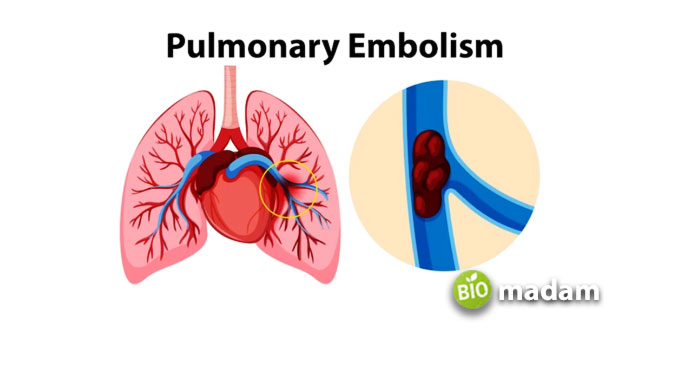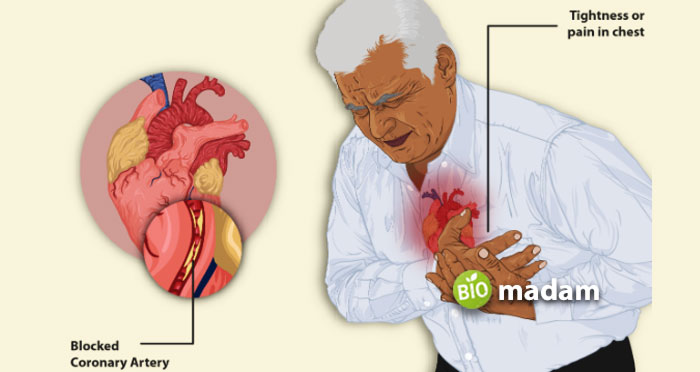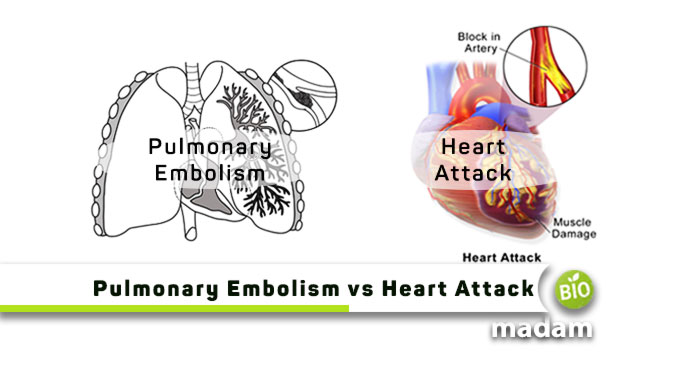Recently updated on October 30th, 2023 at 09:51 am
Pulmonary embolism may lead to a heart attack, despite that they are different conditions. Pulmonary embolism refers to a blockage in a pulmonary blood vessel, whereas a blockage in your coronary artery causes a heart attack.
The most significant difference between pulmonary embolism and heart attack is that they directly affect different organs. PE affects both lungs, and Heart attack or Myocardial Infarction (MI) affects the heart. They arise due to different underlying factors and may be fatal if not treated in time.
Let’s break down the characteristics of pulmonary embolism (PE) and heart attack for your better understanding.
Comparison Table
| Factors | Pulmonary Embolism | Heart Attack |
| Definition | Blockage of blood vessels in the lungs | Blockage in coronary artery |
| Symptoms | Chest pain, shortness of breath, bloody sputum | Sharp pain in chest, and lightheadedness |
| Causes | Deep vein thrombosis | Sedentary lifestyle, and high-cholesterol food |
| Risk Factors | Cardiac issues, pregnancy, birth control, blood clot | >50 years, chain-smoking, unhealthy eating, HTN, etc. |
| Diagnosis | Blood tests, lung scan, pulmonary angiogram | EKG, ECG, blood tests |
| Treatment | Anticoagulants | Aspirin |
| Prevention | Improved physical activity | Healthy diet and lifestyle |
What is Pulmonary Embolism?
Embolism refers to the blockage in an artery or vein. Thus, pulmonary embolism means the presence of a blocking mass, typically a blood clot, in the blood vessels.
Pulmonary embolism is an obstruction in pulmonary arteries in your lungs. Often it is caused by blood clots that travel towards the lungs from deep vein thrombosis in the legs or from another vein in the body.
The blood clot in the artery restricts blood, plasma and oxygen flow to the lungs and can be life-threatening.
Considering the connection between deep vein thrombosis and pulmonary embolism, preventing the former can help alleviate the chances of the latter. If not treated in time, pulmonary embolism may lead to lung damage, heart attack, and even death.
It is important not to ignore the signs and symptoms of pulmonary embolism and diagnose it in time to prevent further damage to the vital organs.

Symptoms of Pulmonary Embolism
The symptoms of PE in one patient may be distinct from another as they vary significantly depending on the size of the clot and previous medical history. However, there are a few signs that may represent pulmonary embolism.
Chest Pain
You may feel a pinching chest pain, like a heart attack. You may also experience difficulty in deep breathing, especially when you bend.
Shortness of Breath
Chest pain accompanied by shortness of breath is the most prominent representation of pulmonary embolism in patients. It may also occur while you are at rest.
Coughing and Wheezing
Sometimes patients with PE experience bloody sputum while coughing. On the contrary, some patients do not report bloody coughing.
Besides these three fundamental symptoms of PE, you may find PE through a few other accompanying signs and symptoms.
- Irregular and rapid heartbeat
- Excessive sweating
- Pale colored skin
- Swelling in leg calf due to deep vein thrombosis
- Feeling anxious
- Fainting
Causes of Pulmonary Embolism
The main cause of pulmonary embolism is the presence of blood clots in the blood vessels. Blood clots in the arteries or veins may be due to many reasons.
- Blood may collect in certain parts of the body, usually the leg or the arm resulting from long periods of inactivity.
- Underlying medical diseases or conditions like congestive heart failure, stroke, or atrial fibrillation.
- Vein injury due to surgery or fracture.
- Increase or decrease in clotting factors in the blood due to birth control pills or HRT.
High Risk of Pulmonary Embolism
While anyone can have PE, some people are more susceptible due to lifestyle or medical conditions. Some of the risk factors for Pulmonary Embolism include:
- Obesity
- History of stroke or heart failure
- Injury in vein, trauma, or varicose veins
- Recent insertion of venous catheters through the leg or arm
- HRT, birth control pills, or recent pregnancy
- Being inactive for a long period during traveling
Diagnosis
Following tests can be performed to confirm if the patient is suffering from pulmonary embolism or not:
- Blood tests
- Lung scan
- Pulmonary angiogram
- Leg ultrasound
- CT scan or MRI
Treatment
After confirming the presence of pulmonary embolism, you will be given anticoagulants for at least 5 days. The treatment may continue for up to 3 months until your condition improves. You can recover from pulmonary embolism if you diagnose and treat it in time.
Prevention
Pulmonary embolism can be prevented by avoiding deep vein thrombosis and taking adequate measures. Compression stockings and elevating your legs for a few minutes every day can help improve blood flow. Improving physical activity and using blood thinners also reduce the risk of pulmonary embolism.
What is a Heart Attack?
A heart attack refers to the restricted flow of blood to the heart. It could be due to thrombosis or embolism in the coronary arteries.
The blockage in the blood vessel could be due to fat buildup or deposition of other substances along the walls of the artery. The cholesterol deposits are known as plaque which leads to atherosclerosis. The plaque may detach from the artery and give rise to embolism.
The restriction of blood flow to the heart can result in a heart attack, also known as a Myocardial Infarction (MI).

Symptoms of Heart Attack
The symptoms of a heart attack are typically the same in most cases, including:
- Sharp chest pain with a feeling of tightness and heaviness
- Pain spreading to your arms, neck, jaw, and tummy with passing time
- Excessive sweating without an apparent cause
- Shortness of breath
- Feeling nauseous or throwing up
- Indigestion and fullness
- Coughing or wheezing triggered by shortness of breath
- Feeling dizzy and lightheaded
While the symptoms do not vary much, pain in the jaw or back and nausea is more common in women than men.
Causes of Heart Attack
Heart attack majorly arises from coronary artery disease due to blockage. It usually occurs due to the presence of embolism or thrombosis. There are a few other reasons for heart attack, including:
- Complete heart artery blockage due to STEMI (ST-elevation myocardial infarction).
- Partial blockage as a result of NSTEMI (non-ST elevation myocardial infarction).
- Coronary artery spasm causes a severe squeezing of blood vessels and constricting movement of blood cells.
- Spontaneous coronary artery disease may also lead to a heart attack because of a tear in the artery.
High Risk of Heart Attack
Blockage in the coronary artery generally arises from a high-fat and high-cholesterol diet. However, a few more factors increase the risk of a heart attack. Some of them are:
- Men of age more than 45 and women more than 55 years
- High blood pressure
- Obesity
- High cholesterol diet
- Unhealthy diet
- Diabetes
- Smoking
- Tobacco use and other substance abuse
- Family history of heart attack
- Sedentary lifestyle
- Stress
- Autoimmune conditions like lupus, psoriatic or rheumatoid arthritis
Diagnosis
Following tests can be performed to confirm if the patient can experience heart attack in near future or not:
- EKG
- Blood tests
- ECG
- Cardiac catheterization
- Stress testing
Treatment
The initial treatment of a heart attack includes taking an antiplatelet like aspirin or nitroglycerin to improve blood flow to the heart. Sometimes the patient may require a balloon angioplasty or stent placement.
Prevention
While the chances of a heart attack increase with age and comorbidities, you can reduce risks by taking a few preventive measures. Follow a healthy lifestyle by taking care of your diet and avoiding smoking. Furthermore, managing other health conditions like hypertension and diabetes can help reduce chances. Remember to take medication at the time as directed to avoid complications.
Difference between Pulmonary Embolism and Heart Attack
Definition
Pulmonary Embolism
Pulmonary embolism is the presence of a blockage in the blood vessels in the lungs.
Heart Attack
Heart attack refers to the insufficient blood supply to the heart due to coronary artery blockage resulting in improper heart functioning.
Symptoms
Pulmonary Embolism
The major symptoms of pulmonary embolism include chest pain, shortness of breath, irregular heartbeat, and bloody sputum.
Heart Attack
On the other hand, a heart attack is characterized by a sharp pain in the chest radiating towards the arm, nausea, lightheadedness, and fainting.
Causes
Pulmonary Embolism
Pulmonary embolism may result from deep vein thrombosis or injury in the vein leading to a clot in the pulmonary vein.
Heart Attack
However, a heart attack usually occurs from a partial or complete coronary blockage due to an unhealthy, high-cholesterol diet and a sedentary lifestyle.
Risk Factors
Pulmonary Embolism
The risks for pulmonary embolism increase with underlying cardiac issues, recent pregnancy or surgery, birth control pills, and hormone replacement therapy.
Heart Attack
Contrarily, there is a higher risk of a heart attack post the age of fifty due to chain-smoking, unhealthy eating habits, obesity, and ignoring other health conditions like hypertension.
Diagnosis
Pulmonary Embolism
Pulmonary embolism may be diagnosed by blood tests, lung scans, pulmonary angiograms, leg ultrasounds, CT scans, X-rays, or MRIs.
Heart Attack
Whereas a heart attack is typically diagnosed through an EKG, ECG, blood tests, and stress testing.
Treatment
Pulmonary Embolism
Physicians prescribe anticoagulants for up to 3 months to treat pulmonary embolism.
Heart Attack
Conversely, a heart attack requires immediate intervention through aspirin or nitroglycerin.
Prevention
Pulmonary Embolism
You can prevent pulmonary embolism by avoiding deep vein thrombosis by using compression stockings and improving physical activity.
Heart Attack
An active lifestyle, a healthy diet, quitting smoking, and taking medicines for other medical conditions can help reduce the chances of a heart attack.
The Bottom Line
Pulmonary embolism and heart attack or myocardial infarction is often confused with being interchangeable. While one of them may contribute to the other condition, they are different. The primary difference between pulmonary embolism and heart attack is the blood vessels they affect. PE results from a blockage in the pulmonary artery, whereas heart attack or MI rises from coronary artery blockage. They both are critical diseases that might have originated from an infection, and can lead to death if not treated in time.
FAQs
How to differentiate myocardial infarction and pulmonary embolism?
Pulmonary embolism and heart attack symptoms can be similar, including chest pain, acute dyspnea, syncope, and palpitations. However, an ECG helps understand the condition better as ST-segment elevation MI shows consistent changes in the pattern.
Is an embolism a heart attack?
A pulmonary embolism is not a heart attack but a blockage in the lungs, so it is not a heart attack. However, a cardiac embolism in the coronary artery can obstruct blood movement through the circulatory system and result in a heart attack.
Does CPR help pulmonary embolism?
CPR might not help pulmonary embolism usually, but when suspected as the cause of the myocardial infarction. Doctors suggest prolonged CPR for at least sixty to hundred minutes.
What is the immediate treatment for pulmonary embolism?
Blood thinners and anticoagulants are typically the first line of action against pulmonary embolism. They facilitate the movement of blood through blood vessels easily.
Is pulmonary embolism the same as heart failure?
Despite similar symptoms and risk factors, pulmonary embolism and heart failure are not the same. However, patients with cardiac diseases like coronary artery disease and heart failure may lead to pulmonary embolism.

Anna has completed her degree in Pharmacy from the University of Hawaii. She is serving as a research assistant in a pharmaceutical company. She had a great interest in writing blogs, traveling to different parts of the US, and trying delicious recipes in her spare time.

